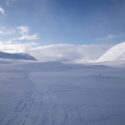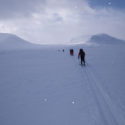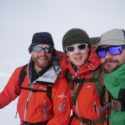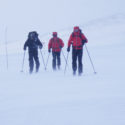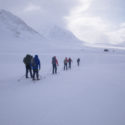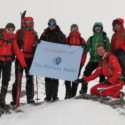‘Cockney Arctic Odyssey’ was an adventurous training expedition sponsored and paid for by the Ulysses Trust. It was organised by Sqn Ldr Jonathan White and LSgt. Barnes and involved 7 members of the HAC and a Lieutenant from the RNR. The expedition leader with the requisite adventurous training qualifications was John Howie, a professional expedition leader, formerly of the HAC and of the RAuxAF; his deputy, ‘Mac’, also a highly qualified expedition leader, was a former member of the TA. The expedition’s objective was to take the team ski touring along the famous Kungsleden or The King’s Trail in Northern Sweden, a 450 km route between Abisko and Hemavan and arguably one of the best and most challenging hiking routes in the world.
A pre-arranged taxi took us to Gatwick where we met our two guides John and Mac and grabbed the early flight to Stockholm where we would get a connecting flight to Kiruna.
Kiruna is Sweden’s most northerly town and lies within the Arctic circle at latitude 67° 51′ 0″ N and longitude 20° 13′ 0″ E. As the plane came in to land, we had our first introduction to the vast, frozen landscape that we would soon be travelling through. We were picked up from the airport by our hosts for the first evening, one of them being a bear of man with a thick beard who wore leather trousers with a knife stuck in to the belt. It became clear that you had to be a particular type of person that chose to live in this harsh environment. Reaching our accommodation in the early evening we were instantly met by howls from the packs of huskies that surrounded the lodge, John and Mac gave us a brief overview of the route and a safety briefing as to its hazards and then we sat down to our first meal of reindeer meat balls. Soon to be labelled by our expedition leader LSgt. Barnes as ‘mixed protein’, this local food stable was to haunt us for the remainder of the trip.
The following day we jumped on the train out of Kiruna and up to Abisko, travelling along snow covered tracks and past frozen lakes, the brief journey gave us all an opportunity to get to know each other and set a good tone for the trip. In Abisko we picked up our ski touring gear and were soon outside and raring to go. The learning curve was fairly sharp and our initial ski was down a frozen road, immediately resulting with the majority of the team falling heavily on their backs. The experience of trying to get up whilst on skis and carrying a Bergen gave new meaning to the phrase ‘Bambi on ice’. The rest of the day was a slow and steady ski to the Abiskojaure Mountain Hut during which the team was bathed in glorious sunshine as we got used to this new method of travel. Our approach to the hut was across a vast lake that had a thick coat of soft snow, not knowing what to expect we were very kindly greeted with warm drinks by the local guardian and shown our accommodation which consisted of a cooking area and cramped sleeping area with beds stacked three high. The loos were some distance away from the accommodation and consisted of some exceptional long drops to crap in. On the other side of the camp we encountered our first taste of the Swedish sauna phenomenon or as the team liked to call ‘naked sauna’. The typical routine was to change and wash prior to walking in to an often cramped sauna room, after a couple of minutes the team would then charge out in to the sub-zero temperatures, roll around in the snow and run back in just in time for someone to very kindly begin offering a nip from their hip flask to warm us up. Needless to say the locals thought we were all completely barking!
The next few days followed a similar format as we skied across the Arctic tundra, a relatively early start with a small break in the middle of the day when we stopped for lunch in one of the many wind huts which are scattered every 15km’s or so along the trail. Each day the route would get progressively longer and despite the terrain being relatively flat it was often punctuated with some steep and fairly lengthy inclines which tested the fitness and skills of even the most athletic members of the group and often resulted in a two steps back, one step forwards situation. Towards the 4th day on the trail the weather changed and the team began to get hammered by high winds and snow, both temperature and visibility dropped considerably and it became very apparent how easily one could get exposed out here. We reached the Tjakta Hut, about 80km in to our route which was heavily overcrowded (due to the harsh conditions, no one could be sent away). The team ended up in a small room with 2 huskies and some disapproving comments from the already resident females over the fact that it wasn’t meant to be mixed accommodation. Diplomatic steps were needed in order to defuse the situation and so a good bottle of single malt was taken out much to the appreciation of the Swedish contingent in the room and turned that evening in to a very comfortable affair.
The route from Tjakta to Singi was less than 20km and we reached the hut just after midday, Mac had raised the idea of providing some cold weather survival lessons earlier on in the week and it was decided that this would be a great way to spend the afternoon. The lessons were split in to three areas, igloo building, snow holes and what was soon to become the infamous ‘quincy’. The latter was seemingly more closely related to being buried alive then surviving an Arctic storm. Picture three men huddled under a windproof sheet with the remaining men being tasked to cover them in snow, an innocent task until you realise the view from the inside is an increasingly shrinking space occasionally interrupted by an angry shout as one of the snow shovellers inevitably cracks you in the head with the end of the shovel. The cries from Mac, to use the ‘soft snow’ were blissfully ignored.
The following morning began with 1.6km trek to a frozen lake next to the local Sami settlement to collect water for the camp, a daily process which involved digging through snow and ice in order to fill up a 20L drum with water and drag it back to the huts as there is no running water. We had a beautiful mornings skiing and the progress the team had begun to make in regards to technique was beginning to show in the km’s we were covering. There was a slightly more treacherous descent to the final hut at Kebnekaise as the stronger winds had already begun to blow the snow off the trail leaving hard ice in its place. As we ended the day, our first view of civilisation in almost a week came with the sudden realisation that our journey was almost over, rather than the usual feelings of euphoria and accomplishment that usually takes place at this point in other long trips, we were hit by a sense of loss of the incredible experiences we were leaving behind.
The heavy storm and high winds (120km/h) of yesterday continued throughout the early morning and we caught the tail end as we left the hut for the final leg of the trip. The mountain side had been sand blasted leaving a path of sheet ice all the way down. Being the tallest member of the team and at the same time an awful downhill skier, the author is happy to admit that he failed badly in his attempt to counter balance the inevitable snow plough with the snow kite that his upper body had become (the new HAC windproof ski touring jackets did a fantastic job of this) and ended up rolling head over heel for the first kilometre or two until the terrain flattened out. The Swedes at this end of the trail had a slightly less gung-ho and some may say sensible approach in this type of weather and a convoy of snowmobiles were soon seen rushing past. After the initial difficulties, the final stretch of the route went without incident and having skied out of the mountains we were relayed by bus to Mushers Lodge in Kiruna.
There was a last attempt to catch the Aurora that night which sadly continued to evade us and we retired at 02:00. Our final day provided a self-funded opportunity to go dog sledding in the morning, this turned out to be a fantastic experience with zero casualties (despite some very narrow misses) and only great memories providing an excellent end to the trip. Our thanks go to the Ulysses Trust for making the expedition possible and to Sqn Ldr Jonathan White, John Howie and Mac for their indispensable contribution to its organisation, planning, execution and , as a result, its success.
The participants were LCpl. Tim Pulham, LCpl. Olly Quinn, Tpr. Patrick Wightman, Lt. James “RAF” Seton (RNR), LSgt. Carl Barnes, Capt. Matt “Diesel Power” Collins, Tpr. Rob “BNP” Kingdon, and Tpr. Ed “Dirty Coops” Cooper.

